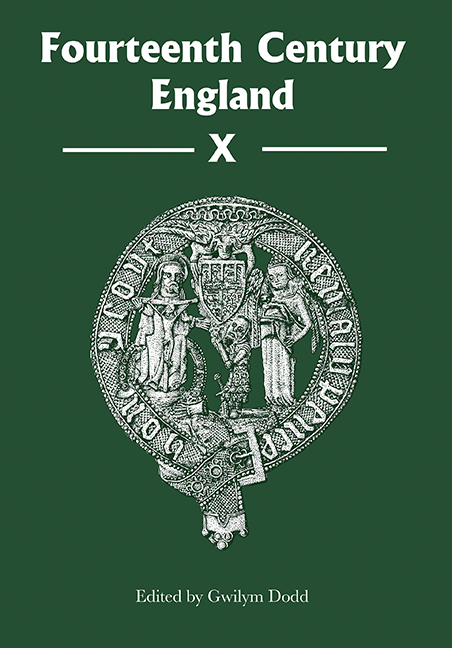Book contents
- Frontmatter
- Contents
- List of Illustrations
- Contributors
- Preface
- Abbreviations
- ‘Bought by the King Himself’: Edward II, His Chamber, His Family and His Interests in 1325–26
- Parliament in the Reign of Edward II
- The Representation of the Clergy in Parliament
- Feeding Mars: Military Purveyance in the Long Fourteenth Century
- ‘Unnatural in Body and a Villain in Soul’: Rape and Sexual Violence towards Girls under the Age of Canonical Consent in Late Medieval England
- Marriage and Inheritance: The Element of Chance in the Development of Lay Estates in the Fourteenth Century
- Mary Percy and John de Southeray: Wardship, Marriage and Divorce in Fourteenth-Century England
- Richard II's Kingship at St Stephen's Chapel, Westminster, 1377–99
- Bodies in Constant Motion: The Burials and Reburials of the Plantagenet Dynasty, c. 1272–1399
- Fourteenth Century England Issn 1471–3020
Parliament in the Reign of Edward II
Published online by Cambridge University Press: 03 July 2019
- Frontmatter
- Contents
- List of Illustrations
- Contributors
- Preface
- Abbreviations
- ‘Bought by the King Himself’: Edward II, His Chamber, His Family and His Interests in 1325–26
- Parliament in the Reign of Edward II
- The Representation of the Clergy in Parliament
- Feeding Mars: Military Purveyance in the Long Fourteenth Century
- ‘Unnatural in Body and a Villain in Soul’: Rape and Sexual Violence towards Girls under the Age of Canonical Consent in Late Medieval England
- Marriage and Inheritance: The Element of Chance in the Development of Lay Estates in the Fourteenth Century
- Mary Percy and John de Southeray: Wardship, Marriage and Divorce in Fourteenth-Century England
- Richard II's Kingship at St Stephen's Chapel, Westminster, 1377–99
- Bodies in Constant Motion: The Burials and Reburials of the Plantagenet Dynasty, c. 1272–1399
- Fourteenth Century England Issn 1471–3020
Summary
The Latin word ‘parliamentum’, and other similar terms such as ‘colloqium’ and ‘locutio’, basically means nothing more than an occasion on which words are spoken. Just what those words might be, spoken by whom, under what circumstances and to what purpose are other matters entirely. John Maddicott has traced the distant origins of the English parliament as an institution as far back as the Anglo-Saxon monarchy in the early tenth century, and there is some justification for such a long view; but it was not until the thirteenth century that the term ‘parliament’ came to mean a formal meeting to which the king summoned his leading subjects to give him advice and to discuss important matters affecting the ‘state of the realm’, such as the approval of legislation in the form of statutes, the granting of taxation, and the answering of petitions. Those summoned initially consisted of the great men of the kingdom or ‘magnates’, together with the bishops and abbots of the greatest monastic houses. Such meetings are recorded from the beginning of the reign of Henry III in 1216; usually they were described in the records as a ‘council’ or ‘colloqium’, but sometimes the cognate term ‘parliament’ was applied, with no obvious reason for the distinction. Examples of meetings called ‘parliaments’ occur in 1236 and 1242, but with increasing frequency in the 1250s and 1260s. Occasionally other groups of people were summoned: representatives of the knights in 1254, 1258 and 1264; and in 1265 two knights from each county together with two burgesses from the leading towns in England. However, apart from the magnates and prelates, there was no fixed composition of parliament, and it was not until late in the reign of Edward I that the attendance of knights, burgesses, and also representatives of the lower clergy became frequent. The description ‘Model Parliament’ has been applied to the assembly of November 1295, at which all these elements were present, although, as we shall see, the practical reality was not so straightforward.
- Type
- Chapter
- Information
- Fourteenth Century England , pp. 25 - 46Publisher: Boydell & BrewerPrint publication year: 2018



